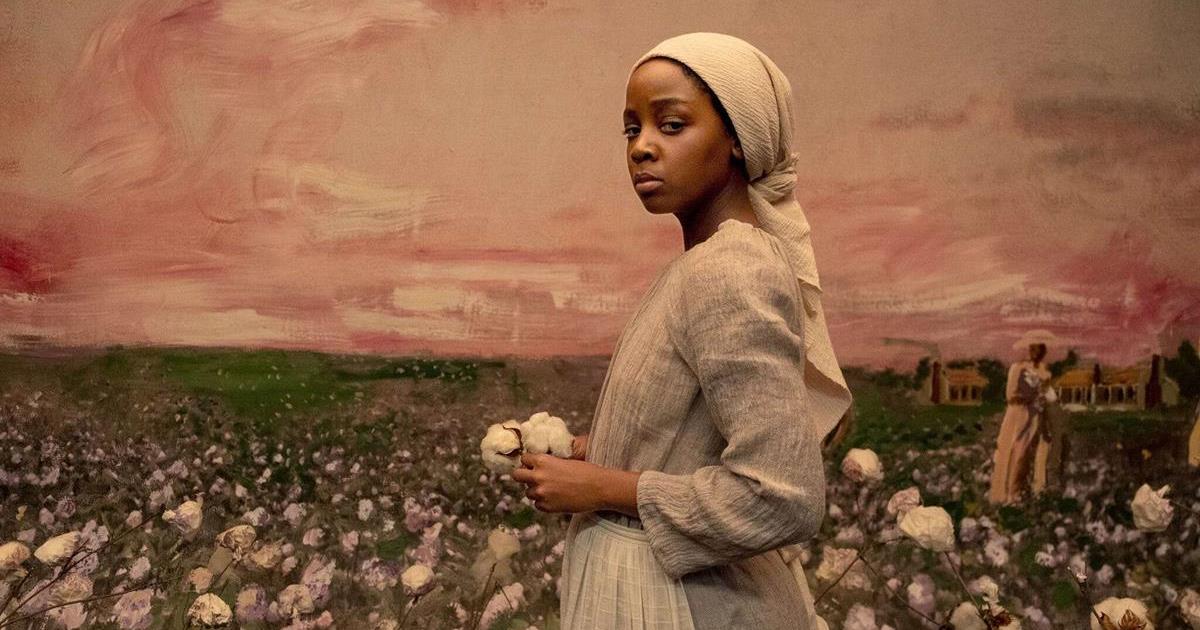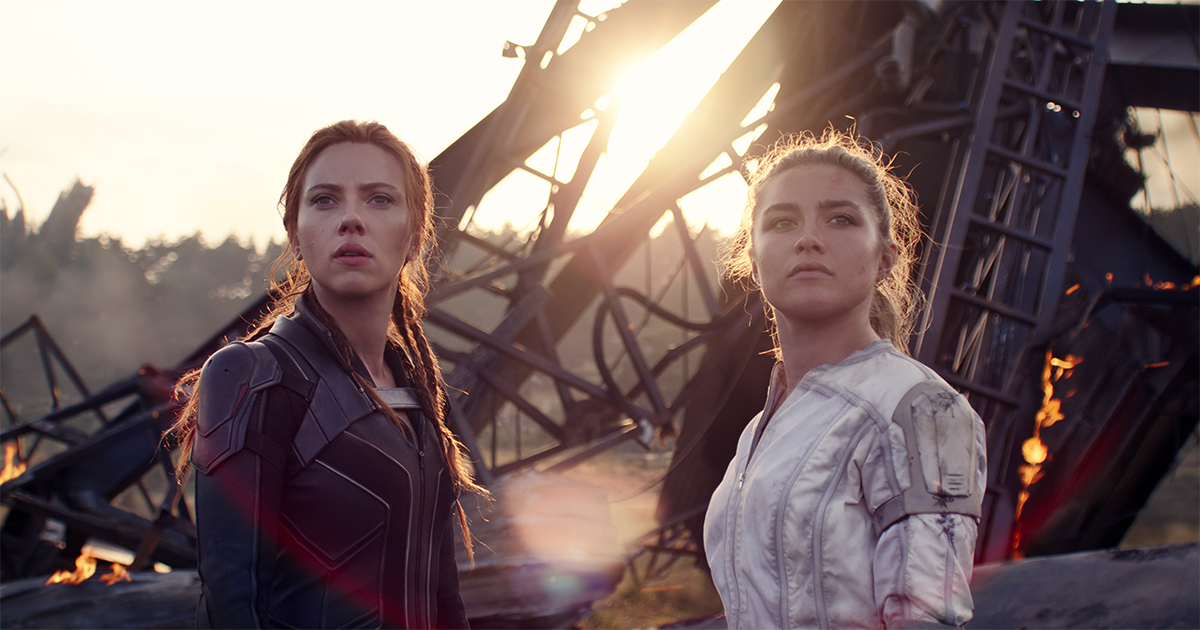
“Y’all wanna hear a story about why me & this bitch here fell out? It’s kind of long but full of suspense.”
So begins the odyssey of A’Ziah King, aka Zola, in a stranger-than-fiction saga relayed in a now-iconic series of viral tweets. King recounted her story back in 2015 in a lengthy sequence of posts on Twitter — 148 in total, preserved for eternity on Imagur. King’s story, a roller coaster ride of an adventure now known as “The Thotyssey,” or simply #TheStory, quickly went viral, with King herself widely credited as the originator of the now-ubiquitous Twitter thread.
“I made people who probably wouldn’t want to hear a sex trafficking story want to be part of it, because it was entertaining,” King told Rolling Stone’s David Kushner later that year.
Writer-director Janicza Bravo (Lemon) was immediately attracted to the outrageous tale of two women who hit the road to score quick cash dancing for money in Tampa, only to find their friendship tested when one of them isn’t who she claims to be.

“It’s funny and unusual and uncomfortable,” Bravo says of King’s highly original story. “It has guts and power in the way that it unfolds. A’Ziah’s tweets felt like the intersection of Cardi B’s “Bodak Yellow” and David Lynch’s Blue Velvet. The text was enigmatic, energized, raw and unfiltered. It seemed to exist on a planet that was just next to ours, somewhere larger than life and deeply saturated.”
The comedy-thriller starts off as a free-spirited, female-centric road movie, before veering off into the seedy underbelly of sex work in Tampa, Florida. The film follows Zola (Taylour Paige), a Detroit waitress who strikes up a new friendship with a customer, Stefani (Riley Keough), who invites her to join a weekend of dancing and partying in Florida. What at first seems like a glamorous trip full of “hoeism” rapidly transforms into a 48-hour journey involving a nameless pimp, an idiot boyfriend, a posse of Tampa gangsters, and other unexpected adventures in this wild, see-it-to-believe-it tale.
But Bravo wasn’t the immediate choice as the film’s director, she reveals in an interview with Mia Galuppo for The Hollywood Reporter — Zola was originally meant to be directed by James Franco.
After learning of King’s Twitter thread via a group chat with friends, Bravo asked her manager and agent to pursue the rights to the story. But without any money to put toward a bid, it was obvious she didn’t have a chance. “I was offering craft,” Bravo told Galuppo. “You can’t buy shit with craft.”
So when Bravo heard that Franco has exited the project because of scheduling conflicts, she threw her hat in the ring, putting a call in to Killer Films, the production company that had helped secure financing for her first feature, Lemon. She met with producers repeatedly over the course of three months, trying to sell them on her vision for the film. Bravo secured the job in May 2017, with A24 — fresh off its Oscar win for Moonlight — signed on to finance and distribute the film.
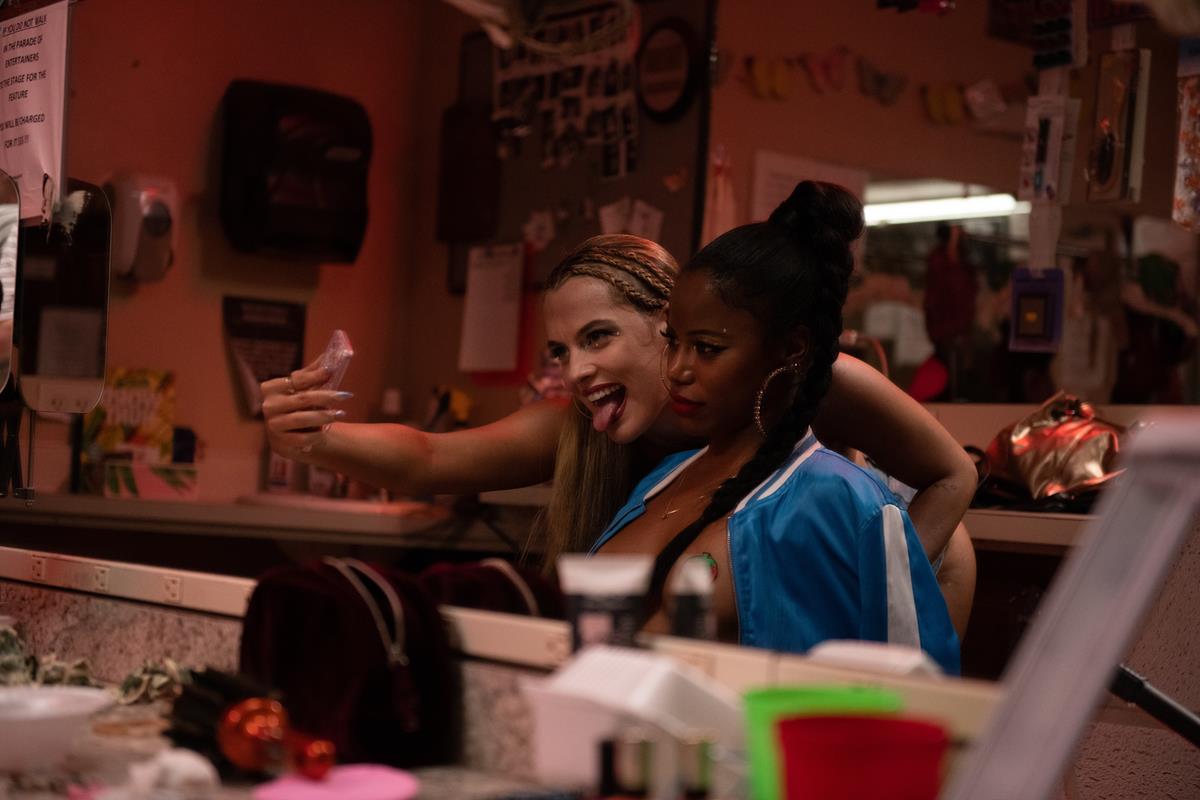
In January 2018, eight full months after Bravo had replaced Franco as the director, the Los Angeles Times published a report in which the actor-director was accused of sexually inappropriate behavior by multiple women, the majority of whom were students at his Studio 4 films school. Then, months later, in June, word leaked out that Bravo was taking the helm of Zola, and a curious narrative began to form.
“The better story to tell was that he was accused and then a cleanup crew comes in. Like, ‘You know how we fix it? We throw in a director. And, you know, if she’s Black? Points,’ ” Bravo explained.
“I actively worked to get this,” Bravo added. “So I don’t love any perception that it was handed to me to fix the problem.”

Bravo co-wrote Zola with Jeremy O. Harris, basing the script on King’s epic viral Twitter thread as well as Kushner’s article for Rolling Stone, “Zola Tells All: The Real Story Behind the Greatest Stripper Saga Ever Tweeted.” (Kushner received a story credit in the film, as did King, who also received exec producer and consulting credits.)
Bravo told Galuppo about the decision to bring on Harris, who is now known as the celebrated playwright of the Tony Award-winning Broadway play, Slave Play, and has consulted on shows such as HBO’s Euphoria, but at the time was still relatively unknown. Harris was still completing his MFA at Yale and had yet to finish his first screenplay, but Bravo knew she needed Harris — whom she describes as “extremely online” — to properly evoke King’s voice and reach an appropriate tone.
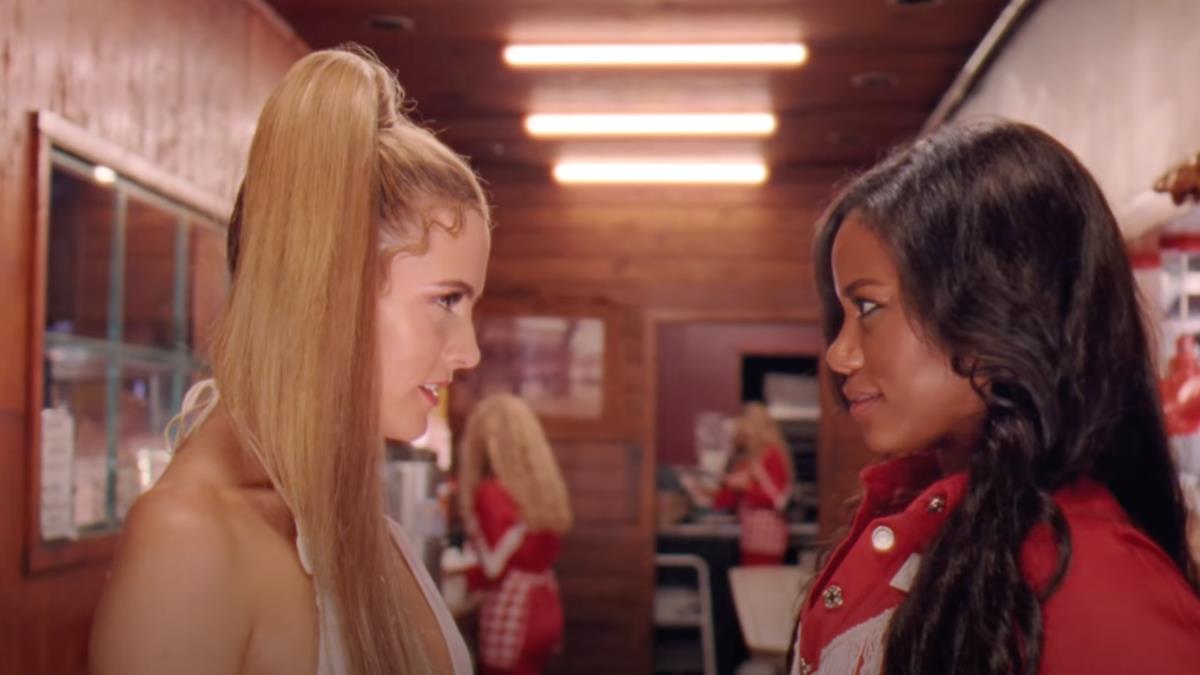
The duo vowed to give King the gravity and respect they knew Hollywood — and film audiences — might not necessarily provide. That included petitioning to have Zola shot on 16mm film in order to give the film the status that comes with celluloid. “I wanted [King] to know that the director that was hired for this movie was going to fight for it to have a legitimacy,” Bravo said.
“I was fortunate enough to shoot Zola on 16mm,” Bravo says in the film’s production notes:
“There is an attitude that happens when you get to shoot on film. It feels inherently important. I knew before I got it that it was how I wanted to memorialize it. I’d never gotten to shoot on film. It was one of my dreams. I gave an impassioned speech that went something like: ‘I don’t know that I’ll ever have this again. This is my chance. There isn’t enough work made by folks who look like me about folks who look like me where the filmmaker gets that choice.’ ”
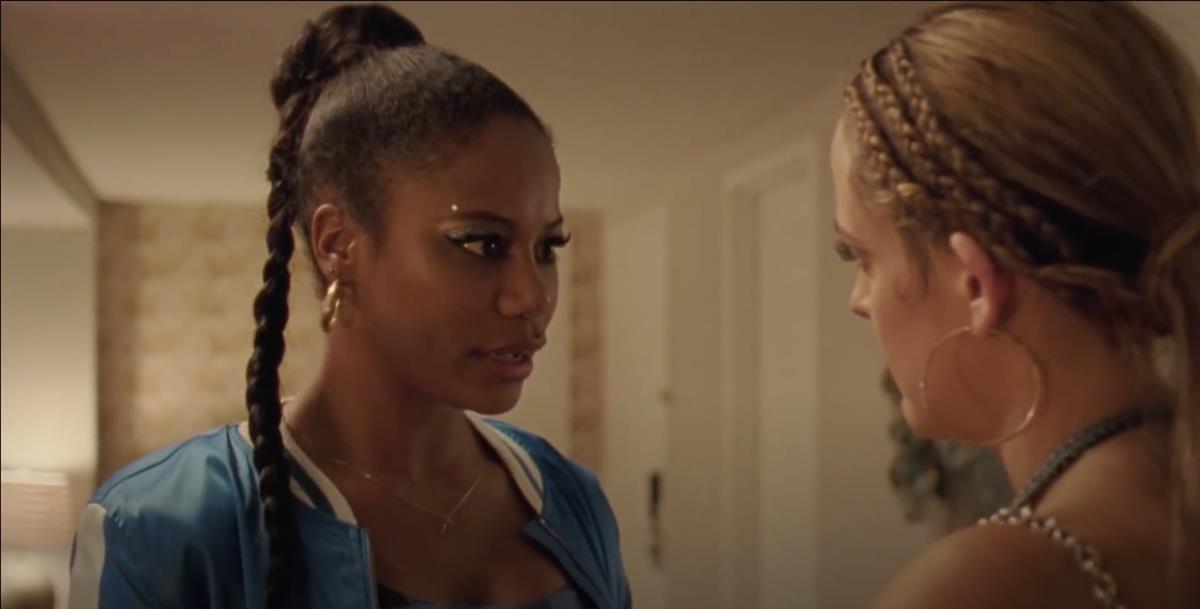
The script Harris and Bravo were handed (written by Andrew Neel and Mike Roberts) showed the duo “how a lot of Hollywood saw the movie in their head,” Harris said. In the first few pages of the script, Zola is seen fully nude, dancing on a pole. But in Bravo and Harris’s version, there is no full female nudity in the film. “It totally makes sense if you are trying to make a 25-year-old white boy in Nebraska perk up to watch this movie,” said Harris. “Showing tits at the very beginning.”
Early in the process, Harris said, “I want to see dicks in this movie,” but that was much easier said than done. During production, when the local casting director in Florida wasn’t able to find male talent comfortable with full frontal nudity, the filmmakers went to a local nudist colony to enlist more willing participants. Bravo recounted how she stood in a hotel room detailing King’s story and explaining that their nudity would be the only nudity seen in the film. “The nudists were all pumped,” Bravo said. “Everyone said, ‘What’s most scary to me is acting.’ ”
READ MORE: “By Tweet 15, I Was There”: ‘Zola’ Director and Writer on Their Journey to Turn a Stripper’s Wild Twitter Thread Into an Absurdist Thriller (The Hollywood Reporter)
The nudists were employed for a montage sequence featuring a dozen different men arriving at a hotel room to have sex with Stefani. Zola watchfully stands by, greeting the men at the door before she sends them in to Stefani, and then we see the men from Stefani’s point of view, taking in the repetition of their faces, bellies and penises.
Bravo spent a long time discussing how to approach this scene with her cinematographer, Australian DP Ari Wegner, she told Jenna Wortham in an interview for The New York Times.
“The conversation started with how nudity looks in American films. It always feels voyeuristic and like the woman who was naked wasn’t in the conversation. There’s always something nefarious and naughty about it,” Bravo said.
The challenge became how portray the labor of sex work without the use of female nudity. “It was in the original pitch,” Bravo noted, describing what Wortham calls “a demure sensuality.”
“I’m most turned on and excited by what I can’t see,” Bravo told Wortham. “The shape of a breast, the shape of a buttock. A clavicle.”

READ MORE: How She Transformed a Viral Twitter Thread About Sex Work Into a Sinister Comedy (The New York Times)
Bravo discussed her approach to filmmaking in an interview with Rachel Handler for Vulture, describing her place in the market as “stressful comedy.” As an example, she returns to the source material for Zola written by King. “The thing she wrote was a piece of stressful comedy,” Bravo said:
“She wrote a trauma comedy. A tragicomedy, if you will. When I finally got the film, people would be like, ‘What’s the movie?’ I’d be like, ‘Oh, yeah, it’s a dark comedy. These two girls become fast friends and go on a road trip to Florida, and one finds out she’s going to be sold into sex slavery, and she’s trying to get out of it.’ And the person on the other end of that was always like, ‘That’s supposed to be funny?’ And I’d be like, ‘No, it’s so funny. It’s sooo funny. I know I just said “sex slavery,” but it’s really funny.’ The truth is, without the humor, I wouldn’t be the right director for it. I don’t have the range for it. Maybe I do, but it’s not a space I’d feel necessarily comfortable in. The part where it’s funny and stressful and dark and uneasy, and sometimes all of those notes being played at the same time, is me.”
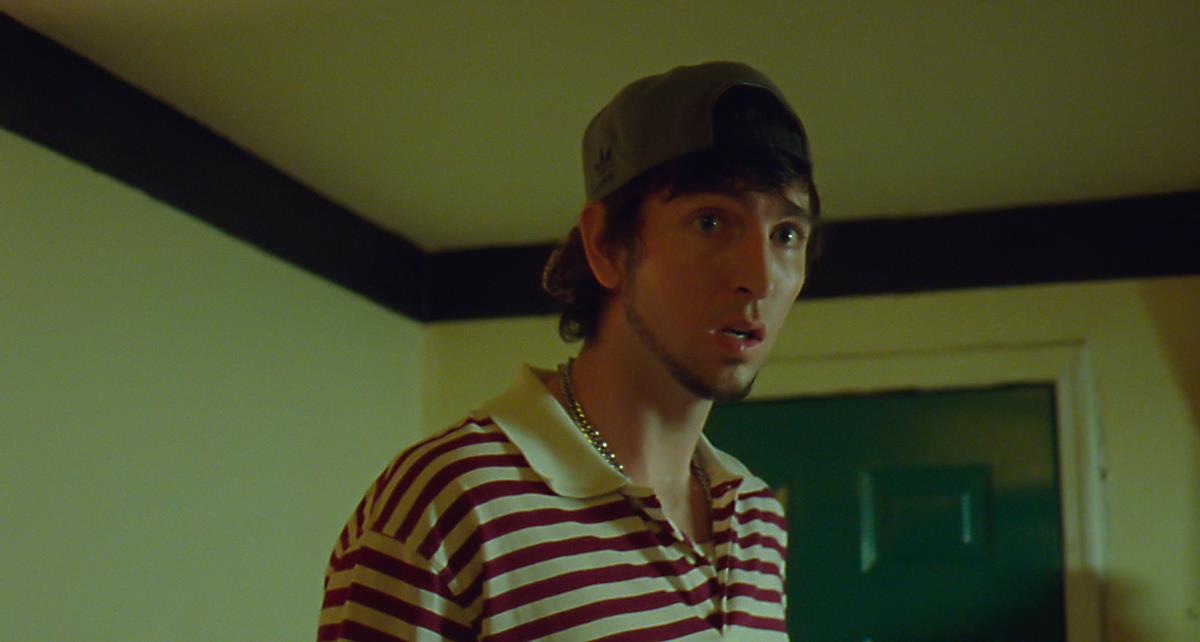
Outside of stressful comedy, Bravo’s filmmaking is “about anthropological whiteness,” she informs Handler. “In the world, we engage with whiteness as though it’s invisible,” she explains:
“I don’t know if it’s just my own experience, but I don’t find whiteness to be invisible. I find it to be incredibly visible. I find it to be sometimes incredibly violent and aggressive and loud, especially when engaging with Blackness or in opposition to Blackness or when in parallel with Blackness. So much of my life is having to be in and out of white spaces that I’m not always invited into. I found myself really fascinated by that because I didn’t see work really engaging with that: What is a Black woman’s experience of being next to whiteness?”
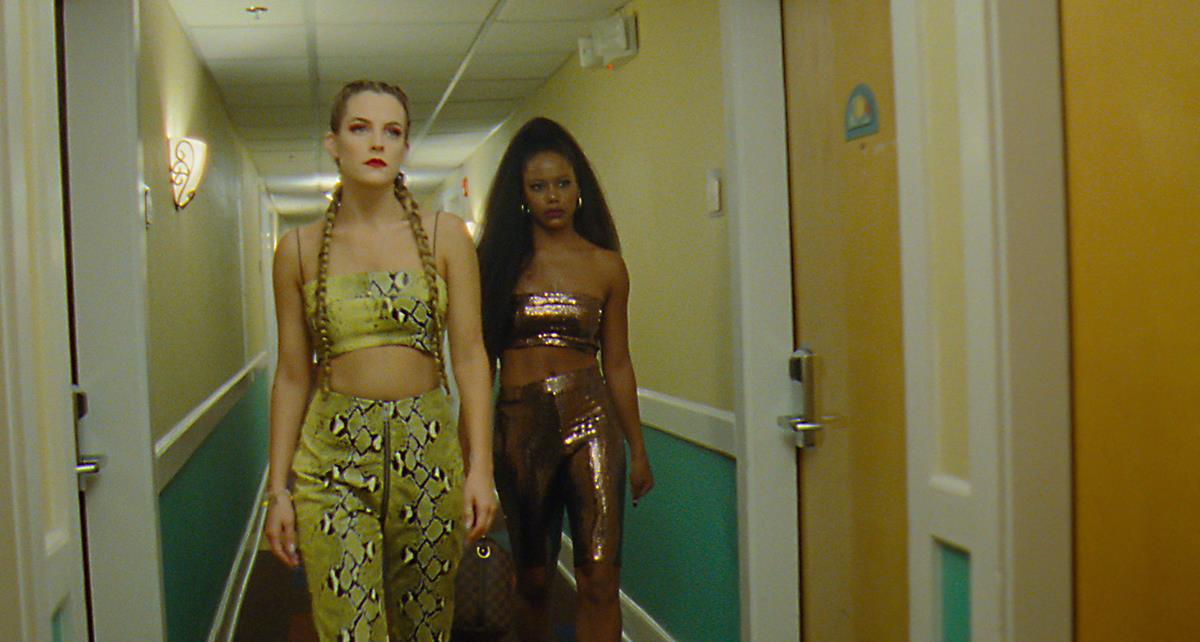
READ MORE: Zola Is Janicza Bravo’s Comic Horror Show (Vulture)
For Zola, Bravo treated 2015 like its own separate period, she told Toussaint Egan in an interview for Polygon.
“I was trying to treat 2015 a little bit like it was a period. Like, to me, we’ve made a period film. 2015 is a time capsule. It feels archival. I mean gosh, wasn’t that just so long ago?” she said in the interview:
“There are these certain things that were introduced to us by way of our cell phones that are now just very much a part of our life, and so I was also trying to call attention to what our relationship were to a certain visual things. Like how they’ve now become embedded. We have sort of a Pavlovian relationship even to the sound cues of social media. There’s a volume button later in the film, there used to be a larger one that was more period specific, but the volume button in the movie resembles more how it looked in 2016 or 2017. The one we were using initially was taken from the 2015 image, which was kind of like a like a triangle of sorts. I ended up getting rid of it because at one of the first screenings, when it came on screen, a lot of people in the audience went to their phones. And I think that our brains are just fucked. Our relationship to our phones is fucked. The other thing that happens too is that there’s a Twitter whistle throughout the movie, and sometimes I’ve noticed people go to silence their phones whenever they hear that. Which to me, I think that’s awesome. I love that. I think that’s fantastic.”
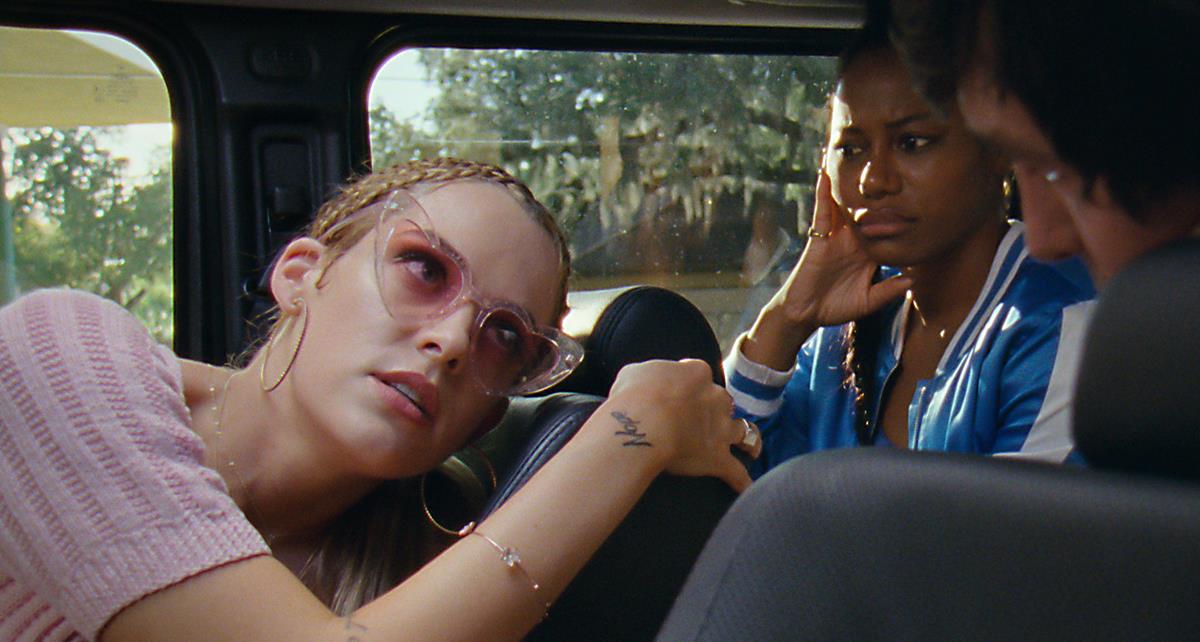
Asked about some of the inspirations for creating Zola’s digital aesthetic, Bravo recognizes that her film achieves something new in terms of representing online culture. “I don’t think that there is a movie that is talking to the internet like I am in this film,” she said. “Or is speaking to like the aesthetics of the digital world like I am. There are plenty of digital gestures in the movie that I haven’t seen used before. I haven’t seen a timestamp in a film; I haven’t seen a screensaver in a film; I haven’t seen the lock screen used in the way that the timestamp is; I haven’t seen texting used as monologue and sort of treated like a Shakespearean aside. And maybe they do exist, I just haven’t seen that movie.”
READ MORE: For Zola director Janicza Bravo, ‘stressful comedy’ is a genre to aspire to (Polygon)
As a Black woman working in Hollywood, Bravo tends to look for “co-signs” that she has a viable career, she told Tambay Obenson in an interview for IndieWire. One co-sign, Obenson notes, is Bravo’s recent addition to the venerated Criterion Collection.
“Chided in 2020 for effectively shutting out Black directors from its library, it’s rare that a filmmaker of any color enters the selective Criterion canon so early in their careers, as Bravo has,” Obenson writes. “Currently streaming on the label’s SVOD platform are four of the filmmaker’s ‘brilliantly outré shorts’ which showcase ‘the singular, gonzo sensibility that has made her one of American independent cinema’s most exciting voices,’ as Criterion states.”

Obenson places Bravo in the pantheon of Black female filmmakers creating space for Black representation in Hollywood :
“With Lemon and now Zola, as well as a handful of earlier short films (including the 2013 Sundance short-film jury award winner, Gregory Go Boom), Bravo joins Stella Meghie as Black women directors in Hollywood making films that occupy spaces in which they are barely represented: funny stories told with literary panache, set in distinct worlds, revolving around acerbic characters often at a crossroads. Radha Blank (The Forty-Year-Old Version) is a recent addition to this fledgling club. Collectively, they all can be considered progeny of the late Kathleen Collins, who described Losing Ground, her feature debut, as ‘a comedy about a young woman who takes herself too seriously.’ ”
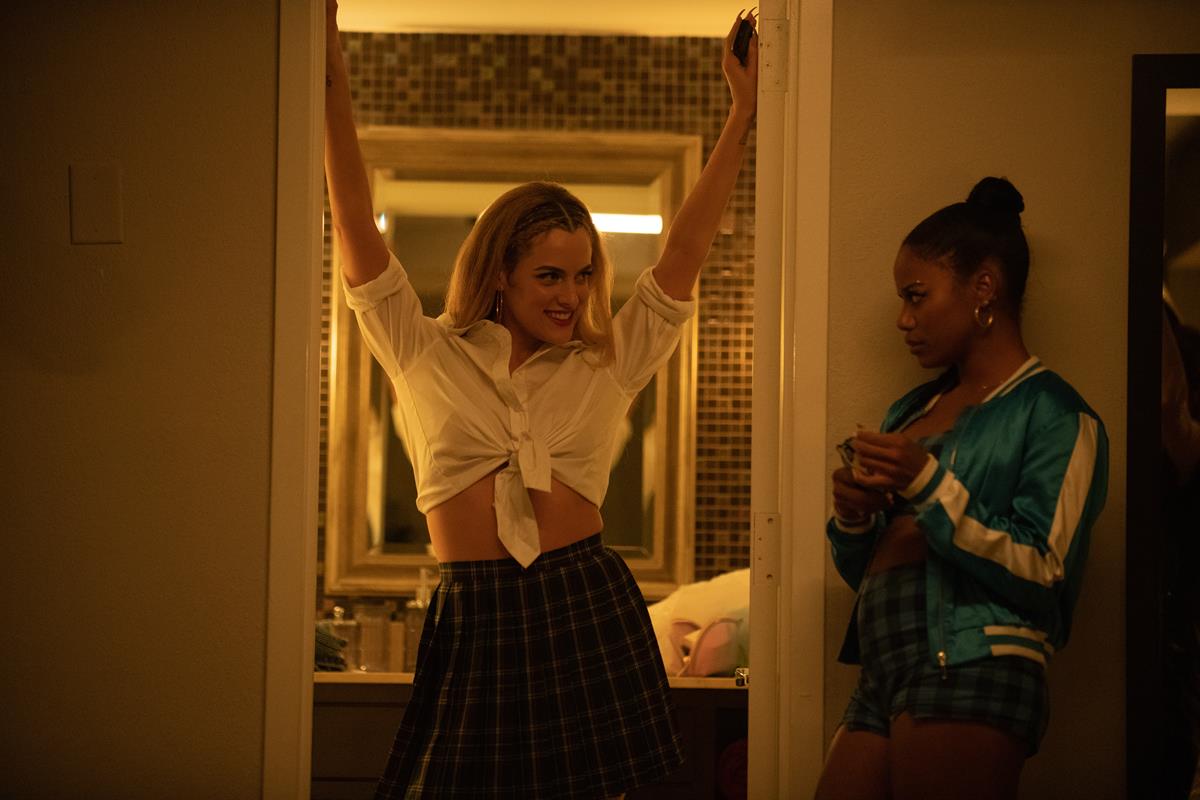
READ MORE: With ‘Zola,’ Janicza Bravo Seeks Space in Comedy for Black Women Filmmakers with an ‘Unusual Lens’ (IndieWire)
Bravo discussed her vision for Zola, and the importance of having Black women tell these types of nuanced stories, in an interview with Ural Garrett for Complex.
“It is very important,” the director underscored. “I’m not only right for this movie because I am a woman and a person of color. I am a comedy director. This movie is a comedy. It is a dark comedy, and my lane in comedy is specifically stressful comedy. I am more right for it because of that. Being Black and also a woman is just like a bonus on top of a bonus,” she said.
“Should Black women get to tell these types of stories, absolutely? But I don’t think we should just be throwing any stories at them. I think they should be telling stories that they feel close to. They should be telling stories that they see themselves in. And if they happen to see themselves in a story where the protagonist doesn’t look like them, we should also allow them the room to make that story.”

READ MORE: How ‘Zola’ Director Janicza Bravo Properly Adapted 2015’s Wildest Twitter Thread Into Cinema (Complex)
Want more? In the audio player below, listen to Deadline’s “New Hollywood Podcast” episode with Zola director Janicza Bravo, where she discusses how A’Ziah King’s Twitter thread presented a new kind of narrative for film:
You can also watch the chilling poolside scene from Zola with commentary from director Janicza Bravo in The New York Times’ Anatomy of Scene.
“What I’d hoped here is that the scene would remind us that some of our relationship to sex work, sex slavery is something that we have the privilege of getting to experience at an arm’s-length distance,” Bravo says in the episode. “And here, it tells us that it’s actually right next to us. And it’s whether or not we choose to see it.”
You can also listen to Zola co-writer Jeremy O. Harris and on-screen talents Taylour Paige and Riley Keough in conversation with NPR’s Aisha Harris in the audio player below:
And be sure to check out director Janicza Bravo in conversation with NPR’s Mallory Yu about the filmmaker’s relationship with A’Ziah King and how she was involved in the filmmaking process:
In the video below, director Janicza Brown discusses her film Zola during a seminar at the AFI Conservatory, including her collaboration with writer Jeremy O. Harris, Hierinymus Bosch’s “The Garden of Earthly Delights,” and her how the film Clueless had an influence on crafting this story:


